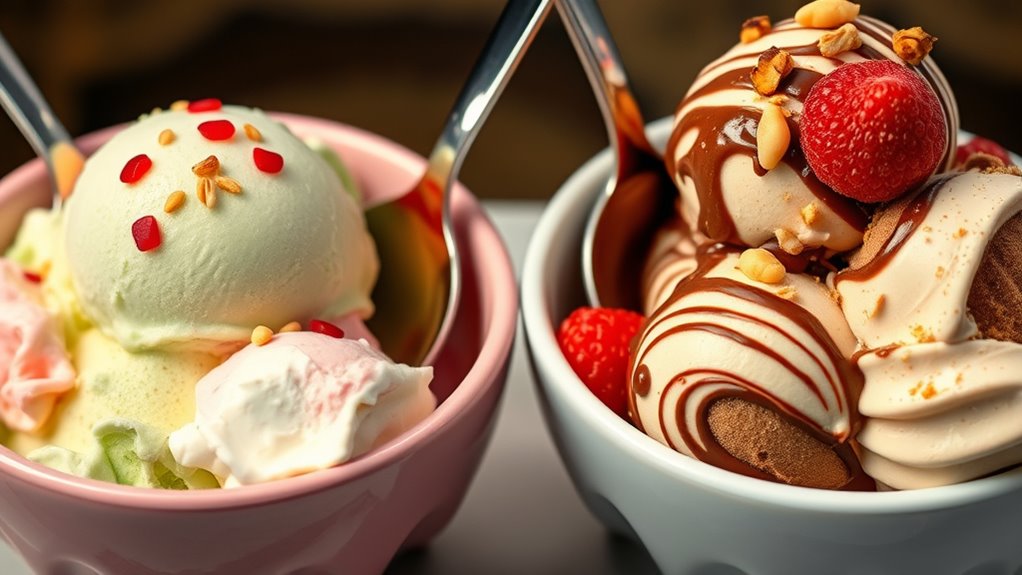When comparing gelato and ice cream, gelato tends to be the healthier choice. It’s lower in fat and calories while offering bold flavors that don’t compromise on taste. Gelato contains around 3-9% fat compared to ice cream’s 10-25%. Plus, it often uses natural ingredients, making it a better option for health-conscious consumers or those with dietary restrictions. Want to explore more about their differences and why gelato might be the better indulgence?
Key Takeaways
- Gelato typically contains 3 to 9% fat, while ice cream has a higher fat content ranging from 10-25%, making gelato lower in fat.
- A serving of gelato has around 90 calories, compared to ice cream’s 125 calories, indicating gelato is the lighter option.
- Gelato is often made with natural ingredients, offering intense flavors without the richness of egg yolks common in ice cream.
- Although gelato may have slightly more sugar, its lower fat content can make it a healthier choice for many consumers.
- Gelato offers vegan options, catering to dietary restrictions and providing a delicious alternative to traditional ice cream.
Differences in Ingredients

When it comes to the differences in ingredients, gelato and ice cream offer distinct experiences.
Gelato primarily uses milk, resulting in a milky taste and a lower fat content due to less cream compared to ice cream. This ratio gives gelato a denser texture. Additionally, gelato contains only 5 to 7% fat, which further distinguishes it from ice cream. Many gelato makers also prioritize natural ingredients to enhance flavor. For instance, some artisanal gelato recipes incorporate fresh fruits to achieve vibrant, natural flavors. Historically, the use of nutritional seeds like chia has also inspired gelato makers to explore innovative flavor combinations. Moreover, the trend of sustainable business models is influencing some gelato producers to focus on eco-friendly sourcing of ingredients.
Gelato features a milk-based formula, offering a milky flavor and denser texture with lower fat content than ice cream.
On the other hand, ice cream contains more cream, making it creamier and richer. Additionally, ice cream often includes egg yolks, enhancing its flavor and texture, while gelato typically skips them, relying on alternative thickeners like carob flour in some variations.
Both desserts use natural sweeteners, but gelato’s intense flavors come from its natural ingredients.
Ultimately, these ingredient differences shape the unique characteristics of each treat, from taste to texture.
Nutritional Comparison

While both gelato and ice cream delight your taste buds, their nutritional profiles differ considerably.
Gelato typically contains fewer calories and less fat, usually ranging between 4-9% fat compared to ice cream’s 10-25%. However, gelato can have more sugar, leading to a higher carbohydrate count. For instance, vanilla gelato has about 90 calories and 3 grams of fat per serving, while vanilla ice cream has around 125 calories and 7 grams of fat. Additionally, ice cream requires at least 10% milk fat to be legally labeled as such, which contributes to its creamier texture. A juice cleanse can promote weight loss through reduced calorie intake, similar to the calorie differences between gelato and ice cream. Consuming desserts with low caloric density can help maintain a balanced diet and support weight management. Furthermore, both gelato and ice cream often contain minimal essential nutrients, making them indulgent options rather than nutritional staples.
Interestingly, the U.S. is the largest consumer of ice cream worldwide, highlighting the popularity of both gelato and ice cream in dessert culture. Despite gelato’s denser texture, portion control is essential since their calorie content can be similar by volume.
Both treats offer minimal calcium and protein, making them indulgent options rather than nutritional staples.
Moderation is key to enjoying either dessert responsibly.
Production Methods

Although gelato and ice cream both satisfy sweet cravings, their production methods set them apart considerably.
Gelato is typically made onsite in small batches, ensuring freshness and a denser texture due to less air being incorporated during churning. This slower process enhances its silky feel and minimizes ice crystal formation. Additionally, the color accuracy of the ingredients used in gelato plays a role in its appealing presentation and flavor integrity. The churning process of gelato is slower, leading to its unique creamy consistency. Furthermore, gelato often utilizes high-quality ingredients that can enhance its overall flavor profile. This emphasis on content quality is akin to how well-crafted food products can elevate the overall dining experience.
In contrast, ice cream is often mass-produced, allowing for longer storage, but it incorporates more air, making it lighter and fluffier. Ice cream can also include stabilizers and preservatives, while gelato emphasizes high-quality, natural ingredients. Furthermore, gelato has less air, which contributes to its denser consistency and richer flavor.
Additionally, gelato is served at a warmer temperature, enhancing flavor release, which is another aspect that distinguishes these two delightful treats. This temperature difference highlights gelato’s ability to deliver a more intense flavor experience than traditional ice cream.
Health Considerations

Understanding the health considerations of gelato and ice cream is essential, especially if you’re mindful of your dietary choices.
Gelato usually contains 3 to 9% fat, making it lower in fat and calories compared to ice cream, which has at least 10% fat. However, gelato often has slightly more sugar, so keep that in mind. Ice cream’s higher fat content can coat the tongue, delaying the detection of flavors, which may influence your overall enjoyment of the treat. Additionally, both treats can be enjoyed in moderation, as excess sugar intake can lead to health risks such as weight gain and increased blood sugar levels. Interestingly, frozen yogurt can be a healthier dessert option for those looking to reduce fat and calories while still enjoying a sweet treat. Adopting a diet rich in raw foods may also provide health benefits that complement your dessert choices. Moreover, incorporating vegan options can enhance your dessert experience while catering to dietary preferences.
Gelato typically has 3 to 9% fat, making it a lower-calorie option than ice cream, but it may contain more sugar.
Both treats provide similar protein levels, but gelato’s macronutrient balance is usually better due to its milk base.
While gelato can cater more easily to dietary restrictions like veganism, moderation is key for both desserts due to their high sugar content.
Ultimately, if you’re watching your fat intake, gelato may be the wiser choice for your health.
Flavor Profiles

When you plunge into the world of gelato and ice cream, you’ll discover that their flavor profiles vary considerably, catering to different taste preferences.
Gelato often showcases simple, intense flavors, featuring traditional Italian favorites like hazelnut and pistachio. Its denser texture concentrates the taste, enhancing each bite. A must-have flavor for authenticity is pistachio, which should contain real pistachios for the best experience. Interestingly, gelato often utilizes plant-based ingredients to enhance flavor depth while keeping it rich. Additionally, gelato’s focus on traditional recipes ensures that each flavor remains true to its origins. Its rich texture can also be likened to the analgesic properties of certain essential oils, which add depth and comfort to their respective uses. Moreover, gelato’s ingredients, such as high-quality fruits, can provide antioxidant benefits, contributing to overall health.
In contrast, ice cream offers a bold variety of flavors, with mix-ins and toppings that create a diverse experience. You might enjoy combinations like peanut butter fudge or seasonal favorites like pumpkin. Gelato’s vibrant fruit flavors, due to less air incorporation, stand out, while ice cream’s lighter texture can sometimes dilute its flavors.
Ultimately, your choice depends on whether you prefer straightforward intensity or a mix of flavors and textures.
Consumer Preferences

What drives your choice between gelato and ice cream? Increasingly, it’s about knowing what’s in your dessert.
If you’re health-conscious, you might lean towards gelato for its lower fat content and higher milk-to-cream ratio. Many consumers are becoming more aware of ingredients and are drawn to organic and natural options. In fact, market trends show that dairy-based frozen desserts generate over USD 34.5 billion in revenue, indicating a significant consumer interest in this category. Additionally, an understanding of advance directives can help guide decisions in other areas of life, such as health and wellness. The move towards natural antibacterial options is also reflected in consumers’ preferences for healthier dessert choices.
You might also consider dietary needs, as dairy-free and vegan gelato options are on the rise. Market trends show a growing preference for premium, artisanal products, which means you’re willing to spend more for quality.
With e-commerce making it easier to explore diverse flavors and brands, your choices in frozen desserts have never been more exciting, catering to both indulgence and health-conscious preferences.
Cultural Significance

Although gelato and ice cream may seem similar, their cultural significance varies greatly between regions.
Gelato has deep roots in Italian culture, tracing back to ancient times when it evolved from Arab frozen drinks in Sicily. It symbolizes community and pride, often featured at significant events and family gatherings. You’ll find gelaterias in Italy buzzing with social activity, especially during summer traditions like la passeggiata. This rich history of gelato’s development during the Italian Renaissance highlights its importance as a symbol of Italian culinary heritage.
Gelato embodies Italian heritage, fostering community and pride at gatherings, especially during vibrant summer traditions.
In contrast, ice cream carries different cultural weight, primarily tied to American and British traditions, often enjoyed casually. Its mass production makes it widely available, yet it lacks the artisanal touch gelato boasts.
While both treats are beloved worldwide, gelato often stands out as a celebration of heritage and craftsmanship.
Dietary Restrictions

Many people enjoy gelato and ice cream, but dietary restrictions can influence your choice between the two.
If you’re lactose intolerant, gelato might be a better option since many shops offer vegan varieties made with non-dairy milk like almond or soy. Plus, these versions often skip eggs, making them easier to enjoy.
For vegans, gelato can deliver intense flavors without using dairy or eggs, thanks to plant-based ingredients.
If you’re watching your fat intake, gelato typically contains lower fat content than ice cream, resulting in fewer calories.
It’s important to be aware of common allergens, too. With customizable options available, gelato can accommodate various dietary needs, making it a versatile treat for many.
Making Informed Choices

When choosing between gelato and ice cream, understanding their nutritional profiles can help you make better decisions that align with your dietary goals.
Gelato typically contains less fat—about 4-9%—compared to ice cream’s 10-25%. This lower fat content often results in fewer calories; a serving of gelato has around 160 calories, while ice cream has about 207. Additionally, gelato is served at higher temperatures for creaminess, enhancing its texture and flavor experience. However, gelato can have slightly more sugar per serving. Both options are high in sugar and should be enjoyed in moderation.
If you’re looking for a treat that’s a bit lighter, gelato might be the way to go. Just remember, portion control is key regardless of your choice for maintaining a balanced diet.
Frequently Asked Questions
Can Gelato and Ice Cream Be Made at Home?
Yes, you can definitely make gelato and ice cream at home!
You’ll need basic ingredients like milk and sugar for gelato, while ice cream requires more cream and sometimes eggs. An ice cream churner is helpful, but you can use a blender and freezer instead.
Just remember to chill your ingredients for a denser texture and experiment with flavors to create your unique treat.
Enjoy customizing with your favorite toppings for added fun!
What Are Popular Gelato Flavors Worldwide?
When you think of popular gelato flavors worldwide, you think of classic Stracciatella and rich Chocolate. You think of nutty Pistachio and invigorating Mango. You think of unique specialties like Limoncello and Salted Caramel.
In Italy, you’ll crave Hazelnut and Stracciatella, while the UK favors Vanilla. Spain and France lean towards Chocolate, and Belgium loves Pistachio.
No matter where you are, there’s a gelato flavor waiting to delight your taste buds!
How Long Do Gelato and Ice Cream Last in the Freezer?
When it comes to how long gelato and ice cream last in the freezer, unopened gelato typically stays fresh for 6 to 9 months, while unopened ice cream lasts about 2 to 4 months.
Once you open them, gelato’s best consumed within 1 to 2 months, and ice cream is good for around 6 weeks.
To maintain quality, store them at the back of your freezer and keep the containers tightly sealed.
Is Gelato Suitable for Children?
As the saying goes, “A little treat makes life sweet.”
Gelato can definitely be a suitable treat for children. Its lower fat content and calcium benefits support bone growth, while the carbohydrates provide quick energy. Plus, gelato comes in a variety of flavors that kids love!
Just remember, moderation is key. Teaching kids about serving sizes guarantees they enjoy their gelato while maintaining a balanced diet.
Are There Sugar-Free Options for Gelato and Ice Cream?
Yes, there are sugar-free options for both gelato and ice cream.
You can find sugar-free gelato made with natural sweeteners like allulose or maltitol, while brands like Rebel Creamery and So Delicious offer sugar-free ice cream.
These options cater to various dietary needs, including dairy-free choices.
When you choose these alternatives, you still get to enjoy a delicious treat without the added sugar, making it easier to satisfy your cravings responsibly.
Conclusion
In the battle of gelato versus ice cream, it really boils down to your taste and health goals. While gelato often has fewer calories and less fat, ice cream’s creaminess can’t be beat. Remember, whether you’re indulging like a Roman emperor or just treating yourself on a hot day, moderation is key. So, when you’re at the shop, choose wisely, and savor every scoop—because life’s too short for bland desserts!









